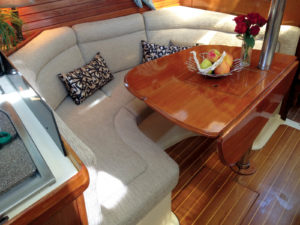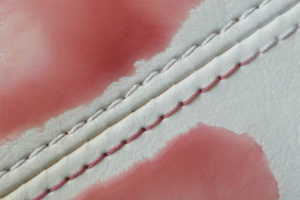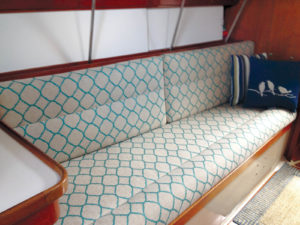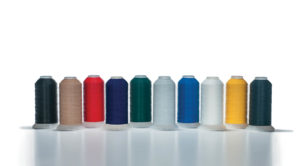Needle and thread know-how
 In every theatrical production there are people laboring behind the scenes, working hard to keep things moving forward seamlessly. Generally unsung (at least by the audience), their efforts are integral to the performance’s success; indeed, without these folks the play would quickly fall apart no matter how well-written the script or how fine the actors.
In every theatrical production there are people laboring behind the scenes, working hard to keep things moving forward seamlessly. Generally unsung (at least by the audience), their efforts are integral to the performance’s success; indeed, without these folks the play would quickly fall apart no matter how well-written the script or how fine the actors.
Although it may seem a stretch to compare the needles and threads used by marine fabricators to a theatrical production, it’s not—these products are as essential as stagehands when it comes to keeping boat covers, seat cushions, window treatments and other projects intact, attractive and performing as expected. And yet, with the exception of deliberately decorative stitching, needles and threads remain largely unseen.
But their role is certainly not undervalued or unappreciated by wise marine fabricators or by needles and threads manufacturers, who continually innovate to help fabricators deliver outcomes that can better withstand the harsh environments their creations are subjected to. Their efforts aren’t going unnoticed.
“There are great strides in threads and needles to complement an ever-changing industry, especially with respect to the new high-tech engineered fabrics,” says Faith Roberts, president of Banner Canvas, a Ham Lake, Minn., marine fabricator providing custom marine exterior and interior products, among others.
“[For example], most people don’t give a second thought to what it takes to make thread,” Roberts continues. “[But] after a tour of American & Efird’s facility I have a new appreciation for the engineering behind a piece of thread.”

It’s not always smooth sailing on the open waters and spills do happen. Shown here is the difference between a white polyester thread, which has picked up a red wine stain, and the stain-resistant GORE® TENARA® Sewing Thread, which has not. Photo: W.L. Gore & Associates, Inc.
Stitch in time
This is welcome news because threads can cause plenty of aggravations for marine fabricators. They can fray, discolor, rot and break—although the latter is frequently due to a needle having a burr on it, which is why it’s smart to keep a fresh needle in the machine at all times, says Tammy Hampton, owner of Cover Girl Marine Canvas & Upholstery. Located in Buford, Ga., the company is a designer and provider of boat covers, cushions and other products (Hampton has also patented the EZ-Xtend Boat Zippers, a fastening system).
These are concerns every marine fabricator has when it comes to threads, says Jacob Blackburn, global marketing coordinator for American & Efird (A & E). Headquartered in Mount Holly, N.C., the company manufactures and distributes industrial and consumer sewing thread, embroidery thread and technical textiles to a spectrum of end users including marine fabricators.
Using a high-quality thread is the obvious first step in avoiding undesirable outcomes, says Blackburn. “As many fabricators know or have found out the hard way, saving a few cents on sewing thread can cost more in the production of a piece or later in replacement costs, or repeat or lost business,” he says. “A product, at the end of the day, must meet expectations.”
Blackburn says A & E suggests when sewing seams in traditional vinyl, polyurethane and leather substrates that marine fabricators use its Sunstop® product. He says Sunstop, designed for outdoor applications, offers advanced UV protection. “It’s dyed using special dyes that include a UV inhibitor for advanced ultraviolet protection that also assists in retarding seam degradation,” says Blackburn. For monogramming, intricate decorative design work and other embroidery applications, the company advises using its Sunbrella® embroidery thread for its colorfastness and “weather durability.”
When determining the right thread for the job, Blackburn says it’s helpful for marine fabricators to understand:
- The project’s end goals. For example, a seat will undoubtedly subject the seams to a lot of stress; would using a Tex 135 or 210 instead make more sense? “Or, maybe you want to accentuate a decorative stitch line, where using contrasting thread colors, using a heavier thread or changing your stitches from eight to four would make a decorative element stand out,” he says.
- The substrates. “Poly and vinyl traditionally don’t play well together,” Blackburn explains. “The chemical reactions occurring in poly thread dyes tend to track, bleeding into vinyl substrates.”

Whether interior or exterior, seat cushions must look attractive while enduring multiple stressors, such as heavy use, sun, salt and water. These interior cushions from Cover Girl Marine Canvas & Upholstery are sewn with thread designed to withstand these challenges. Photo: Cover Girl Marine Canvas
& Upholstery.
Mandy Wittenberg, global engineering leader for W.L. Gore & Associates, says it’s also important for the thread to match the life of the fabric used.
“That way, the seams won’t fail before the fabric wears out,” she says. “Many high-quality marine fabrics are designed to last 10 years and carry a warranty to that effect. [However], most thread isn’t as durable as the fabric into which it’s sewn, forcing fabricators to resew products.”
Located in Newark, Del., W.L. Gore is a global materials science company focused on “solving complex technical challenges in the most demanding environments.” It provides a range of products including GORE-TEX® fabric for the outerwear industry.
“Gore is also the inventor of ePTFE [expanded polytetrafluoroethylene] GORE® TENARA® Sewing Thread,” says Wittenberg. “Originally introduced in 1985, it resists UV sunlight, chemicals, salt water, extreme weather and is ideal for marine and outdoor applications. It’s inherently water-resistant, colorfast, stain-resistant and strong, and is backed by Gore’s limited lifetime warranty.”
The thread is available in 10 colors—including the just-added new Navy Blue—and in regular and heavy weights. It also comes in three weights of clear. The lightweight clear is suitable for bindings, pillows, curtains/side curtains/valances and lightweight cushions; regular weight (clear and colors) is used for most marine and upholstery projects; the heavyweight, three-ply clear and colors is right for sails, heavy clear vinyls, zippers, and areas where added seam strength is required, says Wittenberg.
“Our three-ply, high-strength thread was developed at the request of sail makers,” she explains. “It replaces our two-ply, heavyweight thread, providing the same strength, higher yield per spool and our unique bonding process for easy sewing.”
As for what weight and strength of thread to use when, Wittenberg says that for most marine and upholstery jobs, a 92 Tex thread is best. For sewing bindings and side curtains, marine fabricators may want to consider using a 69 Tex thread, which offers a higher yield per spool.
“Applications requiring high strength, such as sails, heavy clear vinyls and zippers, are best sewn with 138 Tex thread with high linear density,” she advises.

GORE® TENARA® Sewing Thread comes in an array of colors, including the new Navy Blue. This gives marine fabricators the ability to make their stitching invisible or to use decorative and contrasting colors for topstitching. Photo: W.L. Gore & Associates, Inc.
Staying sharp
According to Ron Russell, regional sales and key account manager INH Quality Management for Groz-Beckert®—a Charlotte, N.C., provider of industrial machine needles, precision parts and fine tools—marine fabricators often say they don’t understand sewing needles. They also tend to underestimate a needle’s contribution to the job at hand, he adds.
“[However], the sewing needle is really the most important part of the sewing operation when producing quality products that need to withstand outdoor climates and weather changes,” Russell says. “The needle design and quality of manufacturing assures that the fabricator will get gentle handling of the sewn fabrics, smooth thread handling with tighter stitching and great seam strength and appearance.”
Most marine fabricators use top-of-the-line machines, but a machine is only as good as the needle, he says, mentioning he always tries to stress the importance of using an equally top-of-the-line needle. Use the wrong one, Russell continues, and the results can be skipped stitches, broken thread, dulled points, broken needles and downtime spent in repairing the product or having to start over completely.
Roberts relies on a variety of needles, but prefers Schmetz® and Groz-Beckert.
“Both have a smooth finish and I don’t end up with frayed threads. Groz has a coating on the needles to reduce the friction and heat buildup of the needle,” says Roberts, adding these can be used on fabrics such as acrylics, polyesters, expanded vinyls and woven fabrics, and more.
Problems she hopes to avoid by using the right quality and type of needles? “Usually the problems are from fraying threads to slicing fibers in the fabric,” she says. “These can be hard to see until the product is out in the field and it fails.”
Fracturing of clear vinyls, polycarbonates and other hard surfaces are additional issues, Roberts mentions, that can arise from using the wrong type of needle or those of poor quality. She says this can create a spidering effect which doesn’t show up until after the damage has been done.
Groz-Beckert has engineered a special application needle (SAN® 5.2 GEBEDUR®) designed for many of the materials used by marine fabricators for boat tops, seats, windows, mooring covers and so on, says Russell. The needle replaces the SAN 5 and, according to Russell, the newer version is more technically advanced and is available in a wider size range.
“These are perfect for leather, manmade leather, vinyl, canvas and woven outdoor fabrics,” he says. “The design is perfect for light- to heavy-duty applications and the finished product has very strong seam construction, as well as helping to eliminate wicking, as in boat tops.”
The needles also work well with polycarbonates, Russell adds, and are available with cutting points for these heavier applications. The titanium nitride finish gives these needles a longer working life—up to three times longer, he says—than standard chrome-plated ones.
The type of job and fabric and thread determine the size of the needle used, says Russell, explaining that it must allow the thread to flow smoothly through the eye while not causing problems like skipped stitches or broken thread. Using the correct needle size—with the right thread—is also important to keep from poking holes in the fabric that water can seep through, says Hampton, who cautions this can happen when using overly large needles.
“Sewing needles can be very confusing. Most people have never considered how this 25-cent part can create many problems,” Russell says. “Needle education is very important. We offer needle seminars at many of the shows throughout the year. So, when marine fabricators complain about the difficulty of choosing the correct needle, answers are just a phone call away.”
Pamela Mills-Senn is a freelance writer based in Long Beach, Calif.
 TEXTILES.ORG
TEXTILES.ORG 






